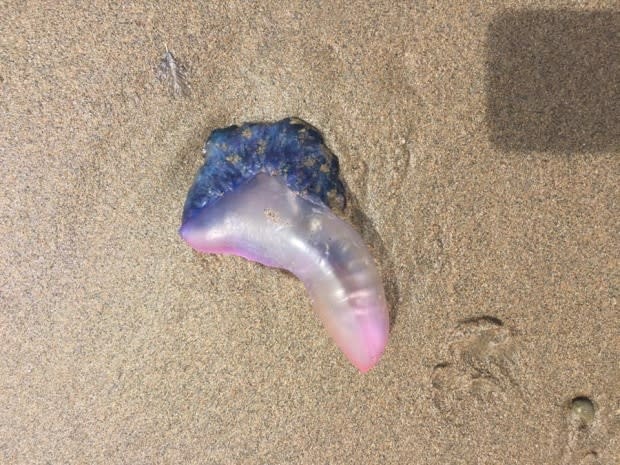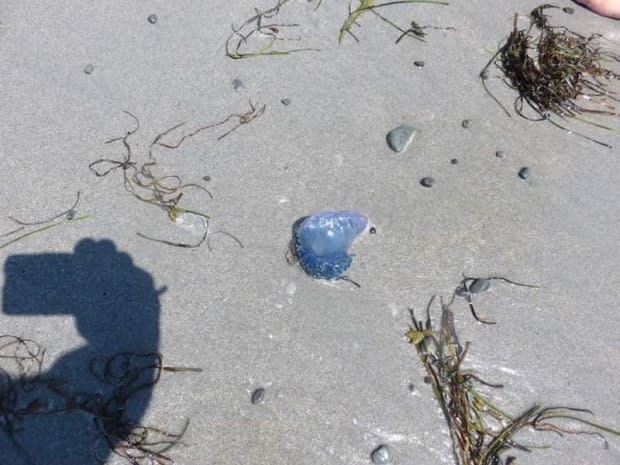Girl, 7, stung by Portuguese man-of-war at Lawrencetown Beach
Kristy Legge's daughter Maria was swimming at Lawrencetown Beach on Sunday when she spotted what she thought were pink sunglasses floating in the water.
The seven-year-old girl was waist-deep in the ocean and reached over to pick up the pretty pink object.
"Then we heard her screaming," Legge said. Her daughter had picked up a Portuguese man-of-war, a pink and purple jellyfish-like creature that can sometimes have a deadly sting.
"She came running out of the water and she still had tentacles attached to her hand.... She was crying like I've never heard. It was pretty painful."

The warmer weather this summer is bringing more tropical sea creatures to the Nova Scotia's beaches, including the man-of-war, which have been spotted at Hirtle's Beach, Rissers Beach and Cherry Hill Beach in the last few weeks.
It's not uncommon for men-of-war to pop up on Nova Scotia beaches from time to time, but Aaron MacNeil, associate professor in the biology department at Dalhousie University, said climate change may mean we'll be seeing more of these species over the next decade.
"We're having an extremely warm summer here in the North Atlantic, so the water temperatures are several degrees higher than they normally are. So as a result you tend to see more tropical species," he said.

Jeannie McLean was at Hirtle's Beach on July 31 when she spotted a man-of-war. She knew what it was and took a picture to share online online and warn other beachgoers.
"It's so beautiful if I didn't know any better and if I was younger I definitely would have wanted to play with it," she said. "I think kids could easily be attracted to it, the beautiful pinks and purples."
IWK treated sting with vinegar
Legge said her daughter was wearing a wet suit, so the sting was contained to Maria's left hand.
"She flung it away and I think some of the tentacles ripped off when she did that and they were stuck on really hard," Legge said. "My sister grabbed the towel right away and started wiping at them and they wouldn't come off right away."
They brought Maria to the lifeguard's station. She was getting pains up her arm and feeling dizzy, so staff suggested she go to the IWK Health Centre. Legge's father put the man-of-war in a bag and brought it with them.
At the hospital, Legge said staff put the man-of-war in some water to get a closer look, while Maria was hooked up with electrodes to monitor her heart.
"They had read it can affect the heart rhythm, but there were no issues with her heart," Legge said. "They treated it with some vinegar, which is very painful, and some warm water."

After a few hours, Maria was allowed to go home.
"She's doing much better, it still stings a little bit," Legge said. "She's using her finger a little bit but it still hurts to move them. You can see where the tentacles were because it left white marks."
MacNeil said the tentacles are like a long, thin thread, which has thousands of individual stinging cells, called nematocysts.
"Each one is on a hair trigger. The more you touch them, the more likely they are to fire off. And each time they fire off they shoot venom into your skin. So what you're seeing is a reaction of your skin to this venom," he said.
"It's very, very painful and the marks can last for months."
MacNeil said if a person does get stung, they should try to peel the tentacles off without wiping them, so you aren't smearing the stinging cells into your skin.

The most common treatment is to use vinegar, but the best way to remove everything and minimize the sting is to shave the area, said MacNeil.
"The razor blades will sever them and remove them from your skin without any darts shooting into you," he said.
While Portuguese men-of-war have caused deaths in the past, MacNeil said that's only in very severe cases.
He said they do tend to wash up in groups, so if you see one, chances are there are more nearby. He said the best thing to do is try to figure out which way the water is moving and where the tentacles are — which can be up to 30 feet long — and try to swim the other way.
"You don't want to stick around, you want to move away from these things," he said. "But for the most part it's not something to be terrified of."
MORE TOP STORIES:


